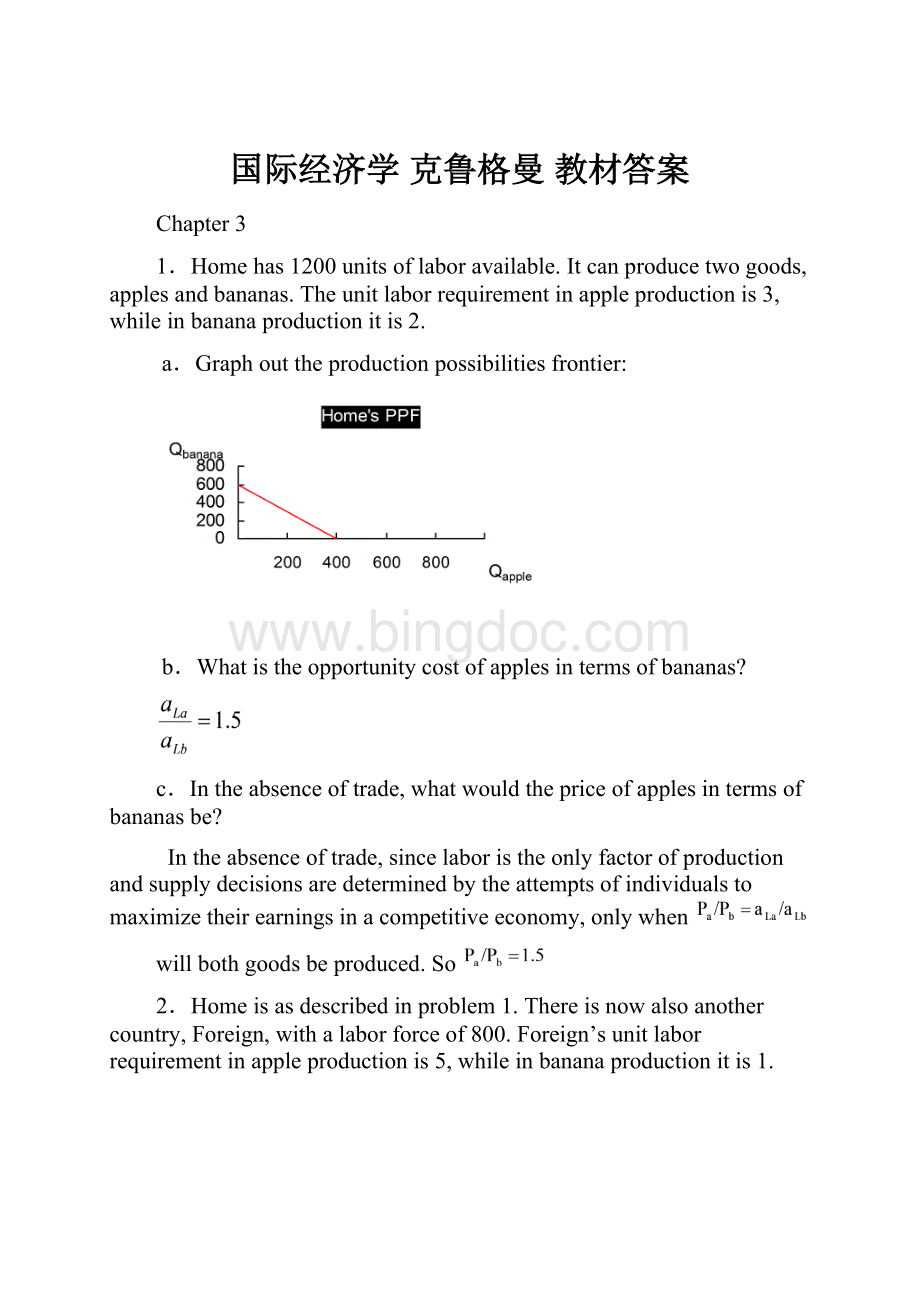国际经济学 克鲁格曼 教材答案.docx
《国际经济学 克鲁格曼 教材答案.docx》由会员分享,可在线阅读,更多相关《国际经济学 克鲁格曼 教材答案.docx(14页珍藏版)》请在冰点文库上搜索。

国际经济学克鲁格曼教材答案
Chapter3
1.Homehas1200unitsoflaboravailable.Itcanproducetwogoods,applesandbananas.Theunitlaborrequirementinappleproductionis3,whileinbananaproductionitis2.
a.Graphouttheproductionpossibilitiesfrontier:
b.Whatistheopportunitycostofapplesintermsofbananas?
c.Intheabsenceoftrade,whatwouldthepriceofapplesintermsofbananasbe?
Intheabsenceoftrade,sincelaboristheonlyfactorofproductionandsupplydecisionsaredeterminedbytheattemptsofindividualstomaximizetheirearningsinacompetitiveeconomy,onlywhen
willbothgoodsbeproduced.So
2.Homeisasdescribedinproblem1.Thereisnowalsoanothercountry,Foreign,withalaborforceof800.Foreign’sunitlaborrequirementinappleproductionis5,whileinbananaproductionitis1.
a.GraphForeign’sproductionpossibilitiesfrontier:
b.Constructtheworldrelativesupplycurve.
3.Nowsupposeworldrelativedemandtakesthefollowingform:
Demandforapples/demandforbananas=priceofbananas/priceofapples.
a.Graphtherelativedemandcurvealongwiththerelativesupplycurve:
∵Whenthemarketachievesitsequilibrium,wehave
∴RDisahyperbola
b.Whatistheequilibriumrelativepriceofapples?
TheequilibriumrelativepriceofapplesisdeterminedbytheintersectionoftheRDandRScurves.
RD:
RS:
∴
∴
c.Describethepatternoftrade.
∵
∴Inthistwo-countryworld,Homewillspecializeintheappleproduction,exportapplesandimportbananas.Foreignwillspecializeinthebananaproduction,exportbananasandimportapples.
d.ShowthatbothHomeandForeigngainfromtrade.
InternationaltradeallowsHomeandForeigntoconsumeanywherewithinthecoloredlines,whichlieoutsidethecountries’productionpossibilityfrontiers.Andtheindirectmethod,specializinginproducingonlyoneproductionthentradewithothercountry,isamoreefficientmethodthandirectproduction.Intheabsenceoftrade,Homecouldgainthreebananasbyforegoingtwoapples,andForeigncouldgainbyoneforegoingfivebananas.Tradeallowseachcountrytotradetwobananasforoneapple.HomecouldthengainfourbananasbyforegoingtwoappleswhileForeigncouldgainoneapplebyforegoingonlytwobananas.SobothHomeandForeigngainfromtrade.
4.Supposethatinsteadof1200workers,Homehad2400.Findtheequilibriumrelativeprice.WhatcanyousayabouttheefficiencyofworldproductionandthedivisionofthegainsfromtradebetweenHomeandForeigninthiscase?
RD:
RS:
∴
∴
Inthiscase,Foreignwillspecializeinthebananaproduction,exportbananasandimportapples.ButHomewillproducebananasandapplesatthesametime.AndtheopportunitycostofbananasintermsofapplesforHomeremainsthesame.SoHomeneithergainsnorlosesbutForeigngainsfromtrade.
5.SupposethatHomehas2400workers,buttheyareonlyhalfasproductioninbothindustriesaswehavebeenassuming,Constructtheworldrelativesupplycurveanddeterminetheequilibriumrelativeprice.Howdothegainsfromtradecomparewiththoseinthecasedescribedinproblem4?
Inthiscase,thelaborisdoubledwhiletheproductivityoflaborishalved,sothe"effectivelabor"remainsthesame.Sotheanswerissimilartothatin3.AndbothHomeandForeigncangainfromtrade.ButForeigngainslessercomparewiththatinthecase4.
6.”Koreanworkersearnonly$2.50anhour;ifweallowKoreatoexportasmuchasitlikestotheUnitedStates,ourworkerswillbeforceddowntothesamelevel.Youcan’timporta$5shirtwithoutimportingthe$2.50wagethatgoeswithit.”Discuss.
Infact,relativewagerateisdeterminedbycomparativeproductivityandtherelativedemandforgoods.Korea’slowwagereflectsthefactthatKoreaislessproductivethantheUnitedStatesinmostindustries.Actually,tradewithalessproductive,lowwagecountrycanraisethewelfareandstandardoflivingofcountrieswithhighproductivity,suchasUnitedStates.Sothispauperlaborargumentiswrong.
7.JapaneselaborproductivityisroughlythesameasthatoftheUnitedStatesinthemanufacturingsector(higherinsomeindustries,lowerinothers),whiletheUnitedStates,isstillconsiderablymoreproductiveintheservicesector.Butmostservicesarenon-traded.SomeanalystshavearguedthatthisposesaproblemfortheUnitedStates,becauseourcomparativeadvantageliesinthingswecannotsellonworldmarkets.Whatiswrongwiththisargument?
Thecompetitiveadvantageofanyindustrydependsonboththerelativeproductivitiesoftheindustriesandtherelativewagesacrossindustries.Sotherearefouraspectsshouldbetakenintoaccountbeforewereachconclusion:
boththeindustriesandservicesectorsofJapanandU.S.,notjustthetwoservicesectors.Sothisstatementdoesnotbadeonthereasonablelogic.
8.AnyonewhohasvisitedJapanknowsitisanincrediblyexpensiveplace;althoughJapaneseworkersearnaboutthesameastheirU.S.counterparts,thepurchasingpoweroftheirincomesisaboutone-thirdless.Extendyourdiscussingfromquestion7toexplainthisobservation.(Hint:
Thinkaboutwagesandtheimpliedpricesofnon-tradegoods.)
TherelativehigherpurchasingpowerofU.S.issustainedandmaintainedbyitsconsiderablyhigherproductivityinservices.Becausemostofthoseservicesarenon-traded,Japanesecouldnotbenefitfromthoselowerservicecosts.AndU.S.doesnothavetofacealowerinternationalpriceofservices.SothepurchasingpowerofJapaneseisjustone-thirdoftheirU.S.counterparts.
9.Howdoesthefactthatmanygoodsarenon-tradedaffecttheextentofpossiblegainsfromtrade?
Actuallythegainsfromtradedependedontheproportionofnon-tradedgoods.Thegainswillincreaseastheproportionofnon-tradedgoodsdecrease.
10.Wehavefocusedonthecaseoftradeinvolvingonlytwocountries.Supposethattherearemanycountriescapableofproducingtwogoods,andthateachcountryhasonlyonefactorofproduction,labor.Whatcouldwesayaboutthepatternofproductionandinthiscase?
(Hint:
Tryconstructingtheworldrelativesupplycurve.)
Anycountriestotheleftoftheintersectionoftherelativedemandandrelativesupplycurvesexportthegoodinwhichtheyhaveacomparativeadvantagerelativetoanycountrytotherightoftheintersection.Iftheintersectionoccursinahorizontalportionthenthecountrywiththatpriceratioproducesbothgoods.
Chapter4
1.IntheUnitedStateswherelandischeap,theratiooflandtolaborusedincattlerisingishigherthanthatoflandusedinwheatgrowing.Butinmorecrowdedcountries,wherelandisexpensiveandlaborischeap,itiscommontoraisecowsbyusinglesslandandmorelaborthanAmericansusetogrowwheat.Canwestillsaythatraisingcattleislandintensivecomparedwithfarmingwheat?
Whyorwhynot?
Thedefinitionofcattlegrowingaslandintensivedependsontheratiooflandtolaborusedinproduction,notontheratiooflandorlabortooutput.TheratiooflandtolaborincattleexceedstheratioinwheatintheUnitedStates,implyingcattleislandintensiveintheUnitedStates.Cattleislandintensiveinothercountriestooiftheratiooflandtolaborincattleproductionexceedstheratioinwheatproductioninthatcountry.ThecomparisonbetweenanothercountryandtheUnitedStatesislessrelevantforansweringthequestion.
2.Supposethatatcurrentfactorpricesclothisproducedusing20hoursoflaborforeachacreofland,andfoodisproducedusingonly5hoursoflaborperacreofland.
a.Supposethattheeconomy’stotalresourcesare600hoursoflaborand60acresofland.Usingadiagramdeterminetheallocationofresources.
WecansolvethisalgebraicallysinceL=LC+LF=600andT=TC+TF=60.
ThesolutionisLC=400,TC=20,LF=200andTF=40.
b.Nowsupposethatthelaborsupplyincreasefirstto800,then1000,then1200hours.UsingadiagramlikeFigure4-6,traceoutthechangingallocationofresources.
c.Whatwouldhappenifthelaborsupplyweretoincreaseevenfurther?
Atconstantfactorprices,somelaborwouldbeunused,sofactorpriceswouldhavetochange,ortherewouldbeunemployment.
3.“Theworld’spoorestcountriescannotfindanythingtoexport.Thereisnoresourcethatisabundant—certainlynotcapitalorland,andinsmallpoornationsnotevenlaborisabundant.”Discuss.
Thegainsfromtradedependoncomparativeratherthanabsoluteadvantage.Astopoorcountries,whatmattersisnottheabsoluteabundanceoffactors,buttheirrelativeabundance.Poorcountrieshaveanabundanceoflaborrelativetocapitalwhencomparedtomoredevelopedcountries.
4.TheU.S.labormovement—whichmostlyrepresentsblue-collarworkersratherthanprofessionalsandhighlyeducatedworkers—hastraditionallyfavoredlimitsonimportsformless-affluentcountries.Isthisashortsightedpolicyofarationaloneinviewoftheinterestsofunionmembers?
Howdoestheanswerdependonthemodeloftrade?
IntheRicardo’smodel,laborgainsfromtradethroughanincreaseinitspurchasingpower.Thisresultdoesnotsupportlaboruniondemandsforlimitsonimportsfromlessaffluentcountries.
IntheImmobileFactorsmodellabormaygainorlosefromtrade.Purchasingpowerintermsofonegoodwillrise,butintermsoftheothergooditwilldecline.
TheHeckscher-Ohlinmodeldirectlydiscussesdistributionbyconsideringtheeffectsoftradeontheownersoffactorsofproduction.Inthecontextofthismodel,unskilledU.S.laborlosesfromtradesincethisgrouprepresentstherelativelyscarcefactorsinthiscountry.TheresultsfromtheHeckscher-Ohlinmo